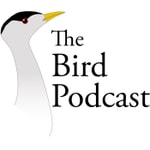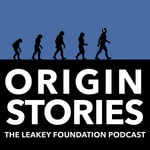Bird Podcast with Shoba Narayan – Details, episodes & analysis
Podcast details
Technical and general information from the podcast's RSS feed.

Bird Podcast with Shoba Narayan
Shoba Narayan
Frequency: 1 episode/39d. Total Eps: 78

Recent rankings
Latest chart positions across Apple Podcasts and Spotify rankings.
Apple Podcasts
🇬🇧 Great Britain - placesAndTravel
25/07/2025#84🇬🇧 Great Britain - placesAndTravel
03/02/2025#89🇬🇧 Great Britain - placesAndTravel
21/01/2025#86
Spotify
No recent rankings available
Shared links between episodes and podcasts
Links found in episode descriptions and other podcasts that share them.
See allRSS feed quality and score
Technical evaluation of the podcast's RSS feed quality and structure.
See allScore global : 38%
Publication history
Monthly episode publishing history over the past years.
Episode 75: Gynandomorphism in birds with Dr. Hamish Spencer
jeudi 21 mars 2024 • Duration 35:35
The sex of a bird – whether it is male or female – is one of the most critical aspects of its biology. Males and females often behave differently, especially during the breeding season, and in many species, they have strikingly different plumages.
This episode features Dr. Hamish Spencer, an evolutionary biologist at the University of Otago in southern New Zealand. Hamish was recently in Colombia, where he was shown a bird that violated these rules.
Colombian ornithologist John Murillo had discovered a very unusual Green Honeycreeper (Chlorophanes spiza) on his farm near Manizales in Colombia and pointed it out to Hamish when he visited early in 2023. The bird exhibited aqua-blue male plumage on its right and grass-green female plumage on its left. The bird’s head showed the black hood of a typical male on the right, but the left side was mostly green.
This episode discusses this bizarre phenomenon, known as bilateral gynandromorphy. How did it affect this particular bird? How does it arise? How common is it? Which species has it been observed in?
The article reporting this find has colour photos taken by John Murillo and is available at https://journal.afonet.org/vol94/iss4/art12/
John Murillo’s video can be seen at https://figshare.com/articles/media/DSCN2268_MOV/23739894
Episode 74: A pigeon’s nest at home and its ripple effects
lundi 11 mars 2024 • Duration 07:44
When a pigeon comes into the house. This is a controversial episode. In fact, I am pretty sure nobody in the nature groups that I am part of will approve of this. In fact, they may even condemn this episode. Because you see, it is about pigeons, which birders call flying pests. But here’s what happened and so, if you listen or watch this episode, advance apologies.
About six months ago, a rock pigeon made a nest in my mother-in-law's balcony. This episode is about the ripple effects after that.
One day, I returned after a long trip and visited my mother-in-law who lives in a separate apartment in my building to discover that a pigeon had laid two eggs on a chair that she uses to sit on in her balcony. My mother in law was quite delighted with this development. She lives alone and having a living creature inhabit her home gave her a lot of pleasure. The problem is that these feral pigeons– rock doves– are carriers of disease.
Bird Podcast is one of the Top 20 science podcasts in India per Feedspot.
Episode 66: Pleasures of birdwatching with Aasheesh Pittie
dimanche 2 juillet 2023 • Duration 34:45
About Aasheesh Pittie’s book of essays, The Living Air. If you’re looking for new ways to engage with birds and birdwatching, Aasheesh Pittie’s book of essays, The Living Air is a great place to start. This book will not only make you want to get out and observe your city and surroundings in a whole new light, but it will also offer a fresh perspective into what birdwatching is and the many ways you can benefit from it. Informative yet a joy to read, The Living Air is an excellent introduction to the transformative pleasures of birdwatching. The Indian Pitta Books is India’s first dedicated book imprint for bird lovers, conservationists and policy makers.
Bio
Aasheesh Pittie is the editor of the ornithological journal Indian BIRDS. He has been the engine behind books such as Birds in Books: Three Hundred Years of South Asian Ornithology (2010), and The Written Bird: Birds in Books 2 (2022). Aasheesh has also compiled a searchable bibliographic database of over 35,000 works on South Asian ornithology (southasiaornith.in).
Questions:
-
For those who haven’t read it, what are the themes in your book
-
Your book begins with the Jerdon’s Courser and the Great Indian Bustard. You are lucky to have seen them. Can you describe this?
-
Your book encourages absorption in bird watching. Were you always this way? What was your evolution as a bird watcher?
-
I loved your chapter, “My kind of birding.” That paragraph about the art of becoming invisible….” Please describe your kind of birding, your thoughts on cultivation of patience and its rewards. What are the rewards? And how can you cultivate this mindset.
-
Dabchicks. How can they absorb you for hours? How can you teach this. ‘Disappearing Dabchicks’. It describes his visit to a local pond, where Aasheesh became entranced by these gloriously ball-like waterbirds and before he knew it, the ‘sun was balanced on the horizon … the disporting Dabchicks had engrossed me for three hours’.
-
In your chapter on the bouquet of Benishaan, you write that “the character of a place, its ambience, takes on the sheen of the temporal moods and perceptions of the observer.” Please elaborate. The context is that many of the places you describe are in South India, but since our audience is global, wanted some takeaways for them as well. So if you live in a particular place, be in Northern Europe or South America, how can you approach birding in the Aasheesh Pittie way.
-
Tell us about your methodical and elaborate list process- now available on ebird. But please describe how you kept notes and the value of those notes?
-
What was your writing process for this book? And how do you know so many specific but unusual words? “but remaining with it through the quiddity of its habitat…”
-
What is your birding routine?
-
What issues absorb you these days?
-
What are your favourite species of birds?
Episode 65: Amazing bird species: Sarus cranes and storks
dimanche 18 juin 2023 • Duration 13:25
In Episode 35, Dr. Gopi Sundar paints a hopeful picture of cranes and waterbirds coexisting with humans. In this episode we delve into these amazing bird species. Both storks and cranes are wading birds. They dwell in similar habitats and look similar. They have long legs and a long, curving neck. However, these birds belong to separate orders and families and aren’t closely related to each other at all. In this episode we look at cranes and storks.
Featured Image: Syed Ahmad from Unsplash.
Episode 64: Flight paths: about bird migration with Rebecca Heisman
dimanche 4 juin 2023 • Duration 17:35
In this episode, we are talking about how we know what we know about bird migration. Our guest, Rebecca Heisman describes herself on her website, as a “bird writer for hire.” Her first book, flight path has the following subtitle: How a Passionate and Quirky Group of Pioneering Scientists Solved the Mystery of Bird Migration. This episode is as much about people as it is about birds.
Episode 63: The Feather Library project with Esha Munshi
dimanche 21 mai 2023 • Duration 42:53
This episode is about the wonder of feathers. Salim Ali said that birds were “feathered bipeds.” This episode explores how feathers are marvellously adaptive to suit birds and species. Our guest is Esha Munshi who co-founded the Feather Library, a digital project documenting feathers.
Esha read a quote from this book on feathers.
Episode artwork: David Clode/Unsplash
From the Feather Library website
A feather lying on the ground could have belonged to any number of species of birds. The type of feather, the colour, the pattern, the markings all tell a story on how to try and identify the owner. Our founding member (Esha Munshi) came up with an idea that if we could compare the feather to an existing database it would help narrow down the options and even help pinpoint the species of the bird. But no such database is in existence for Indian bird species.
In Gujarat alone we have more than 500 bird species. Trying to identify a bird based on just the feather seemed like a daunting task. So it was decided that we would try to record and document as many species as we can. It started with collecting feather samples from Road kills and photographing the feathers. All feathers were counted, measured and photographed. Species details were noted down along with the location.
Our co-founding member (Sherwin Everett) works at an avian hospital in Ahmedabad. The hospital receives around 1500-2000 birds per month, mostly being pigeons, kites and crows along with a fewer other common and some rare species. A number of the birds succumb to their injuries and stress, after which their bodies are discarded to the local corporation for disposal. This was a colossal pool of data just going to waste, literally.
This is the first website for documenting, identification and study of Indian Birds’ flight feathers in India and one of its kind in the World.
A website by the name of www.featherlibrary.com has been setup as the database for the documented feathers. It is open for all and with easy access to feather plates, data regarding the species, wingspan, number of feathers, various other measurements and location of the bird. This will be useful for ornithologists, Forest department staff, researchers, seasoned bird watchers and even creating an interest in budding birders. The main aim is to have all of this data under one roof. Our long term goal is to expand and gradually cover all of India.
Episode 62: Bird diplomacy with Ambassador Jacques Pitteloud
dimanche 7 mai 2023 • Duration 28:15
Photographing birds across continents. In this episode, we interview His Excellency Jacques Pitteloud who happens to be the Swiss Ambassador to the United States. Based in Washington, Ambassador Pitteloud is also a birdwatcher and bird photographer. In 2021, Ambassador Pitteloud’s photograph of a rare painted bunting that appeared in Maryland landed in the Washington Post prompting lots of excitement in the birding world. Later, the Washingtonian ran an article about him, titled, “The Guy Who Got That Photo of a Rare Painted Bunting? He’s the Swiss Ambassador!” He posts his birding photos on his Facebook page. On that page, he posts nothing personal or political. Here he talks about how he developed this passion for birds and some of his favourite regions and birds.
Episode highlights
12:45: his views on the “big year of birding.”
13:45: his view on the different species of bird watchers.
15:00: he talks about two anecdotes in Africa– Kenya. About finding the blue-headed beeeater and the Mackinder’s Eagle Owl.
18:00 mountain passes where you can see raptor migrations. He talks about Chicago’s Magic Hedge in the middle of the city where migratory birds especially warblers (thousands of them) congregate in early May before crossing the Great Lakes.
19:30 about the Connecticut warbler and warbler identification.
21:15 the apps that he uses to identify birds.
22:00 Is there a link between birding and diplomacy? “Birding is the new golfing.”
24:15: what photographic equipment does he use. He uses Canon. 600mm F4 lens. Camera is D90. With 500mm lenses he shoots handheld. With the 600mm he uses a tripod.
26:00 his favourite birds. Raptors. How they move differently.
27:15 about his Indian Facebook friends.
Episode 61: Bird conservation: experiments that work
dimanche 23 avril 2023 • Duration 14:11
In this episode, we highlight conservation experiments that are interesting and have worked. We have chosen three experiments from previous episodes. Our hope is that you will go back and listen or watch sections of these episodes because they are worth your time.
The first conservation plan that worked comes from Episode 50 where we interviewed Professor Yossi Leshem of Israel. He is a bird migration specialist and worked with the Israeli armed forces to help prevent bird and aircraft collisions. The way he did this was by mapping the migration routes of large birds, such as pelicans, storks, and raptors. The fact is that 1 billion birds migrate through Israel each year. Go to 1:30 to listen to about ten minutes of this fascinating episode to see how the Israeli defense forces prevents bird and aircraft collisions.
The second episode that we highlight is Episode 14 where we interviewed Chris Wood, who is in charge of the ebird program at the Cornell Lab of Ornithology. Chris talks about how the Nature Conservancy (an NGO) adopted an ingenious programme in which the rented the rice fields from the farmers who populate the Central Valley of California in order to make their fields available for migrating birds. Go to 42:42 to listen to about ten minutes of this fascinating episode.
The third episode that we highlight is Episode 13 where we interviewed Sy Montgomery about how California condors were saved from extinction. This was done through a political action plan where the use of lead bullets was banned and copper bullets were used in their place. Go to 9:00 to listen to about ten minutes of this fascinating episode.
And lastly, we asked you to go back to watch Episode 29 where millions of migrating Amur falcons are saved through a magnificent community conservation effort
Featured Image: Julia Craice/Unsplash
Episode 60: The race to save our vanishing birds with Beverly and Anders Gyllenhaal
dimanche 9 avril 2023 • Duration 45:10
Beverly and Anders Gyllenhaal are veteran journalists and birdwatchers. They ran newsrooms, assigned features and wrote books. They publish a website called FlyingLessons.US: What We’re Learning from the Birds,’’ and are here with us to speak about their new book, “A Wing and a Prayer: the race to save our vanishing birds.
Questions:
-
What is the thesis of your book
-
Your book begins with a sparrow and a woodpecker. Tell us about that.
-
One third of the birds have disappeared from North America. Shocking statistics. Discussion
-
The bald eagles resurgence in North America. Do you think this has to do with size and resonance as the nation’s symbol?
-
Scrub jays symbolise the balance between human development and endemic birds. How does this play out?
-
Using sound to protect a storied species: california spotted owl.
-
Cerulean warblers in Ecuador. Talk about the Choco Corridor and multiple countries that need to work together
-
Hawaii is the extinction capital of the world. Why? And How can this change?
-
The red cockaded woodpecker and the US military. Coexisting with birds
-
Outline some case studies of getting this done.
-
Making a case for birds.
Episode 59: The big year of birding with Noah Strycker
dimanche 26 mars 2023 • Duration 43:07
In this episode, we talk to Noah Strycker. Noah is the Associate Editor for Birding Magazine and author of several popular books about birds. He set a world record in 2015 by finding more than 6,000 species of birds in one calendar year. 6,042 species to be precise. Noah has made more than 70 expeditions to Antarctica and the high Arctic, literally spreading the joy of birds from pole to pole. In this episode, we talk about the countries he has visited, the species that he has seen, what he learned from his big year of birding, the equipment he carries and how to replicate this exercise should you want to. You can connect with Noah via his website: https://noahstrycker.com/








